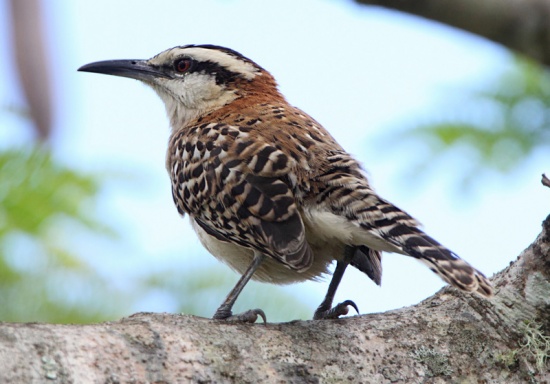- Campylorhynchus rufinucha
Identification
17cm. Black crown and eyestripe, white supercilium, rufous nape, and cinnamon-brown upperparts streaked with black and white. The wings and tail are barred with black and greyish-white. The underparts are white. Young birds have duller upperparts and buff underparts.
Distribution
Mexico, Costa Rica, Guatemala, Honduras, El Salvador and Nicaragua.
Taxonomy
This species has in the past been treated as three species and a new paper is proposing to use that treatment again. These are here treated as groups:
- C.r. rufinucha is an isolated population on the plains of east-central Veracruz, Mexico. This is medium in size. The resulting species would be monotypic.
- C.r. humilis is a small form found along the Pacific coast of Mexico south to about Laguna La Joya in the western Isthmus of Tehuantepec. The resulting species would be monotypic.
- C.r. capistratus is a large form found along the Pacific coast from Laguna La Joya to northern Costa Rica. This form would include existing subspecies C.r. nigricaudatus, xerophilum, nicaraguae, and castaneus.
Near Laguna la Joya is a population of medium size that probably originated as a hybrid population when the large and the small forms came into secondary contact. The paper referred to above argue that this is a narrow, stable zone of contact.
Habitat
Forest or open woodland, scrub, second growth and savanna.
Behaviour
It builds a spherical nest with a side entrance and lined with seed down in thorny trees or shrub. The female alone incubates the 3-5 brown- or black-spotted white eggs for about 2 weeks until hatching. The young fledge after a further 2 weeks.
The diet includes insects, spiders and other invertebrates.
References
- Abstract of a new paper evaluating the taxonomy of Rufous-naped Wren.





